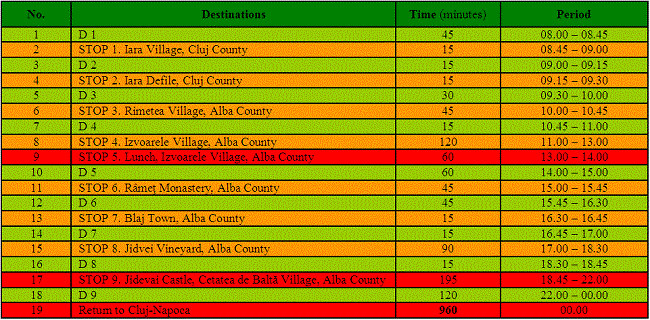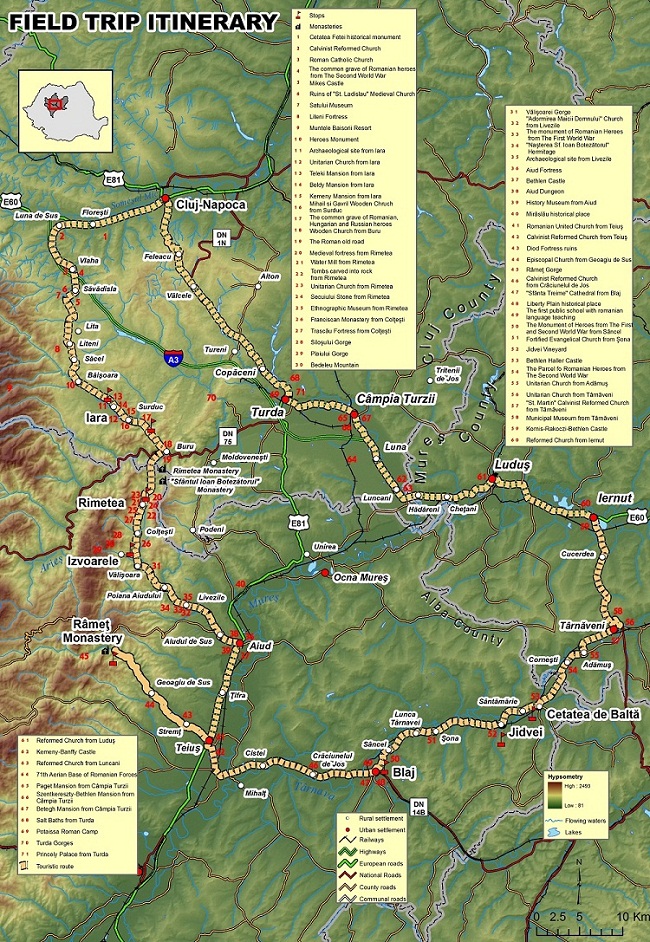




The 6th edition of the International Conference on Rural Space and Local Development (RSLD 2014) debating
Peripheral Rural Areas between Certain Existence and Uncertain Development
July 23-27, 2014, Cluj-Napoca, ROMANIA
GENERAL CONFERENCE PROGRAMME
Wednesday, July 23rd, 2014 Arrival and accommodation of participants 19:00 – 21:00 Welcome cocktailThursday, July 24th, 2014 08:00 – 09:00 Registration of participants 09:00 – 11:00 Opening ceremony 11:00 – 11:30 Honorary ceremony 11:30 – 12:00 Coffee break 12:00 – 14:00 Plenary session (4 keynote speakers) 14:00 – 14:30 Artistic performance 14:30 – 16:00 Lunch 16:00 – 18:00 Cluj-Napoca City Guided TourFriday, July 25th, 2014 08:00 – 10:20 Panel sessions 10:20 – 11:00 Coffee break 11:00 – 13:40 Panel sessions 13:40 – 15:00 Lunch 15:00 – 17:40 Panel sessions 17:40 – 18:00 Coffee break 18:00 – 19:00 Closing Ceremony 20:00 Conference dinnerSaturday, July 26th, 2014
Field trip – departure at 08:00, from the main building of Babeş-Bolyai University, 1, M. Kogălniceanu St, Cluj-Napoca
0. Departure
We’re leaving in the morning from the Main Building of Babeș-Bolyai University (1, M. Kogălniceanu St.) in Cluj-Napoca. We are heading southward, towards the Apuseni Mountains, more exactly towards Hăşdate Valley. We’ll stop in Iara village, a settlement 41 km away from Cluj-Napoca. On our way, we will drive through the following villages: Luna de Sus, Vlaha, Săvădisla, Lita, Liteni, Săcel, and Băişoara, Feleac Hill being on the right side and the Apuseni Mountains and Iara-Hășdate Lowland, on the left.
1. Iara Village, Cluj County
Iara is the main village in this commune and its most flourishing economic period coincided with iron ore mining. It is also a very efficient polarizing centre for its hinterland, but is does not have enough economic strength to change its administrative rank. It also has a well-defined hinterland and this has led to multiple nominations for acquiring the rank of town. Unfortunately, it has not happened yet as there is no other type of industry or economic branch with enough importance to fully replace the local industry and to improve the local economic situation. Regarding the local production process, the main attraction point is the animal sale market.
Even if there are other several villages that became cities (as they were economically more powerful than Iara), this phenomenon has not occurred in this region because of incoherent, uneven development, the effect being a constant marginalization process.
A good proof of the previous industrial activity in this region is the presence of the blocks of apartments built for the mine workers (Iara used to be a mining colony), blocks that are currently dilapidated because of lack of funds. Another proof is the abandoned mining dumps that pollute the area (as they are not covered, a stronger wind will blow the dust up in the air, generating thick mist layers over the entire valley).
Even though formerly known as a central (developed) economic area, nowadays Iara Village is continuously regressing economically thus turning into an economically peripheral rural area.2. Rimetea Village, Alba County
This place has had a very interesting history as it has evolved from the rank of medieval village to the rank of a flourishing city during the 17th and 18th centuries, its decline period stretching between the end of the 19th century and the end of the 20th century. Since 1996-1997 this village has gone through a difficult transition period.
For almost 15 years, this village has changed its economic functioning from an economy based on agriculture to a complex one wherein tourism holds an important place. This village can stand as an example of how a village located in a peripheral rural area, without any perspectives of development, can change into a village that develops mainly on tourism.
From a socio-cultural standpoint, the local community has gone through profound changes (similar to those in economy); the residents of Rimetea started to acknowledge the local architectural heritage (especially the houses built in the 17th, 18th and 19th centuries); they also favoured the renovation of old buildings instead of replacing them with new ones. Moreover, they learnt to be proud of their architectural heritage and to keep it safe from the cultural threat of modern buildings. Due to these preservation projects, Rimetea received the European Committee Europa Nostra Award in 1999 for preserving its material cultural heritage (this was the first Europa Nostra Award won by a Romanian village or town/city).3. Izvoarele Village, Alba County
From an administrative point of view, this village is part of Livezi Commune and it is located north-west of Alba County, at the spring of Aiud River, a affluent of Mureș River. It is also one of the few Romanian villages characterized by economic autarchy (resulted from people’s farming equipment, their non-collective farming methods and the zero support from the state – self-sufficiency). This phenomenon occurs due to a strong sense of ownership or property and due to the fact that the village was not affected by the Communist system of collective property.
Izvoarele village is currently going through a process of depopulation, with 800 inhabitants in 1990 and only 150 inhabitants in the present. Thus, it is highly probable that the village will soon become a museum or it will be transformed into a secondary residence village. Izvoarele village can stand as an example of village that was able to preserve their cultural and architectural heritage due to its location in a peripheral area. It is one of the villages left in Romania where agriculture-related activities are practiced based on animal traction and man-handled equipment. Due to its specificity, this traditional Romanian village looks like an inhabited open-air museum.
The decision on setting the location of Izvoarele Village was made by taking into account the need and availability of lowland along the Aiud River and also the advantages of the mountain that could stand for shelter, springs, hayfields and forest. Therefore, people settled and developed their households at higher altitudes so that they could employ the fertile lowland for agricultural practices. When the number of inhabitants increased up to 800 people, they extended the agricultural land farther away from the village merging into the mountain rocky area, the highest altitude here being of 1,282 m (Cornu Peak).4. Râmeţ Monastery, Alba County
Râmeț Monastery is the most important monastic settlement of the Archbishopric of Alba Iulia, bearing more holy names: the names of the apostles Peter and Paul and of the Dormition of the Theotokos or the Dormition of Our Most Holy Lady or the Assumption (in the case of the big church within the monastery walls, having a surface of 2655ha and being built in the Byzantine style) and the name of The Healing Fountain or The Pool of Bathesda (in the case of the old church, dating from 1300, the last restoration taking place between 1987-1989). A nearby tourist attraction is Râmeț Gorges, a nationally protected area sheltering many karst landforms (sinkholes, natural towers, caves, large scree areas, ridges), as well as Mesozoic and Jurassic chalk rocks (marl, sandstone, conglomerate sedimentary rocks, basalt rocks).
Like other areas in the country, due to the rugged and hardly reachable mountain land this sector of Trascău Mountains represented a safe refuge and shelter for fugitives and combatants in times of conflict, (i.e. social and political convulsions).5. Lookout Point over Blaj Town, Alba County
Situated at the confluence of the two Târnava Rivers and certified by documents from 1252, Blaj is known as the “Little Rome”, being the cultural centre for the Romanian population in Transylvania during the 18th and 19th centuries. It also played an important part in the process of emergence of the modern Romanian language and national identity. In addition, this is the place where the Blaj Bible was printed (which is the second printed Romanian translation of the Holy Scriptures) and where Timotei Cipariu published the first Romanian grammar book (Timotei Cipariu was the president of the Transylvanian Association for Romanian Literature and the Culture of the Romanian People). The number of inhabitants is of approximately 20.000.
One of the most important historically charged places is the Field of Liberty where two national gatherings took place during the 1848 Revolution. People raised a monument here made of the central piece named “Glory” and 26 busts of various leaders of this revolution, as well as of well-known figures of the Romanian cultural life during those times.6. Jidvei Vineyard, Alba County
Jidvei Wines are rooted in the Târnave Vineyard, situated in the hydrographical area of the two Târnava Rivers – Târnava Mică and Târnava Mare.
There is a millennial tradition related to vine planting on these lands and a very good proof for this is represented by archaeological evidence, historical documents and objects specific to vine planting and wine production in this area. The vineyard is situated in a hilly area, with altitudes between 300 m and 500 m. There is a vineyard surface of about 2,000 ha, most of it being located on the southern, south-eastern and south-western sides of the hills, the soil being of the reddish-brown forest type, while the climate is temperate continental with average annual temperatures of 9oC. Jidvei Wine is internationally acknowledged as it has received many national and international awards such as Vinitaly Concorso Enologico 2008, AWC Viena International Wine Challenge 2008 and International Wine Challenge UK 2011. This makes it the largest wine producer in Romania and the best example of practice towards the regeneration of a rural peripheral area.
The group will benefit of a guided tour of the Jidvei Winery.7. The Bethlen-Haller Castle, Cetatea de Baltă Village, Alba County
The castle is located in Cetatea de Baltă Commune, in between the towns of Târnăveni and Blaj, on the left side of Târnava Mică River and it dates back to the end of the 16th century and the beginning of the first half of the 17th century. The structure of the castle is typically Renaissance, corresponding to a compact, rectangular building with 5 roof-covered towers. The building also has more levels, namely the basement, the ground floor and the first floor. The ground floor rooms served as household dwellings or servant dwellings, whereas the upstair rooms were inhabited by the nobleman’s family.
The castle is well preserved with its main architectural Renaissance elements still intact, the same being valid for its Baroque elements added in 1773 when the castle park was also created. The castle and the park are surrounded by a wall granting access through a huge gate. The image of the castle is currently associated with the brand of the Jidvei Wine.
Currently the castle is owned by the Necșulescu family, who also own and manage the Jidvei Vineyard. They are a good example of preservation and management of the cultural heritage in rural peripheral areas.8. Dinner
Dinner will take place at the Bethlen-Haller Castle, Cetatea de Baltă Village, Alba County. The menu is enriched by a session of wine tasting.
9. Return to Cluj-Napoca
Sunday, July 27th, 2014
Departure



